María Elena Torres
Researcher
Technologic Research Institute, INTEC
Santiago, Chile
INTRODUCTION
Soil productivity in arid and semi-arid lands is often hindered not only by the lack of water, but also by the scarcity of nitrogen. Trees and shrubs of the genus Prosopis, family Leguminosae, grow profusely in these areas. These plants offer great potential benefits derived from their capacity for stabilizing and improving soils, making very good use of groundwater and providing shade and fodder, besides giving good fuelwood and charcoal.
The nitrogen fixed by these leguminous species can be partly used by other non-leguminous plants growing near the tree. For instance, Acacia albida is being used in Africa to enhance productivity in peanut, sorghum and millet crops (1), as one example of the evident benefits from the establishment of an adequate symbiosis between leguminous plants and the specific Rhizobium. Once this symbiotic association has been optimized by selecting effective specific Rhizobium strains, the maximum benefits can be obtained by biologic nitrogen fixation. The purpose is not only to insure nitrogen for the plant, but also to improve soil quality and productivity.
Strains are first selected in laboratory, establishing whether they produce “infection” or nodulation in the plant. Consequently, “effectiveness” trials are undertaken first in a greenhouse or growth chamber, and later in the field.
The Rhizobium most commonly infecting the genus Prosopis is the typical Rhizobium of tropical leguminous species.
The taxonomy of the genus Rhizobium has been based to date on its afinity to the host plant. It has been demostrated recently that there are certain strains which can affect several plant groups of different genera. This is quite common for Rhizobium nodulating tropical and sub-tropical plants, such as the Rhizobium for cowpea. This organism has been traditionally considered promiscuous or unspecific; however, in certain cases it has shown considerable specifity (2). This cowpea Rhizobium has been classified as belonging to a new genus: Bradyrhizobium, although not all strains capable of infecting tropical leguminous species can be so classified.
The main purpose of this work is to show the effect of different Rhizobium strains on nitrogen fixation for Prosopis chilensis.
The trial was carried out with seeds collected separately from each tree at two different regions.
MATERIALS AND METHODS
Culture medium
The various Rhizobium strains were cultivated in a solid medium of yeast extract and manitol (3).
Infection trials were made in tubes with nitrogen-free Jensen medium (3).
Rhizobium strains
The Rhizobium strains used are strain 139 (F, originally isolated from mesquite nodules grown in a greenhouse), strain 156 (obtained from NIFTAL, isolated from P. chilensis) and strain 163 (C-2, originally isolated from Prosopis tamarugo nodules growing at the Tamarugal Pampa).
Seeds
Seeds come from a one time collection from a single tree (accession) at each of the sampled populations: Prosopis from Region II (Accession II-1) and Prosopis from Lampa (Accession L).
Seeds were treated with concentrated sulphuric acid for 10 minutes, subsequently rinsed with sterile distilled water, and then placed in Petri plates with agar for germination. Once germinated, they were transferred to tubes with Jensen medium for infection test or to pots with vermiculite for the effectiveness test. They were inoculated with the corresponding Rhizobium strain, measuring 1 ml of inoculum per seed, equivalent to some 107 to 108 cells/ml.
All trials were conducted in growth chambers under controlled temperature conditions, between 29 and 32° C, 14-hour daily photoperiod and 30–40% relative humidity.
In infection tests only the presence or absence of nodules was checked, together with the general aspect of the plant. For the effectiveness tests, results were evaluated four months after the trial was begun, by measuring dry weight of the aerial portion of the plant and total nitrogen, by the Kjeldahl method.
Nodule effectiveness for acetylene reduction was measured by gaseous chromatography, employing usual techniques (4 & 5).
RESULTS AND DISCUSSION
All the Prosopis plants showed nodulation with the tested Rhizobium strains.
Trial findings are summarized in Tables 1 and 2.
Average findings for dry weight of aerial portion, total nitrogen fixed by the plant and nitrogenase activity evaluated by means of the acetylene to ethylene reduction, were statistically analyzed by variance analysis.
The correlation coefficient between dry weight and total weight of the aerial portion is very high (0.96 to 0.99, depending on the treatment). Acetylene to ethylene reduction does not show good correlation with dry weight and nitrogen accumulated by the plant; for some treatments it reached 0.98, while for others it fell down to 0.44.
TABLE 1
Evaluation of biologic nitrogen fixation by three Rhizobium strains in Prosopis chilensis II-1 (1)
| Treatment | Dry weight of aerial portion (mg/plant) | Nitrogen dry basis (mg/plant) | dry weight nodules (mg/plant) | Ethylene (mg/mg-nodule/hour) |
|---|---|---|---|---|
| Strain 139 | 833.3 | 16.2 | 25.4 | 28.9 |
| Strain 156 | 574.4 | 11.0 | 14.4 | 15.8 |
| Strain 163 | 646.1 | 10.9 | 26.8 | 16.0 |
| Control + Nitrogen | 573.6 | 15.6 | 0.0 | |
| Control | 317.4 | 7.8 | 0.0 |
(1) Results are averages for 6 replications.
The variance analysis shows that there is a significant difference between the inoculated treatments and the non-inoculated control, with a confidence limit of 95%. This fact lends support to the hypothesis that these trees respond to inoculation with the appropriate Rhizobium strain.
Additionally, there is no statistically significant difference among the various treatments, when only dry weight is considered. Nevertheless, there is a 90% confidence limit with the analysis for fixed nitrogen. From this analysis it can be concluded that Strain 139 performs better than 163, and this one, in turn, better than 156. This conclusion is corroborated by the mean analysis.
TABLE 2
Evaluation of biologic nitrogen fixation
by three Rhizobium strains en Prosopis chilensis-Lampa (1)
| Treatment | Dry weight of aerial portion (mg/plant) | Nitrogen dry basis (mg/plant) | dry weight nodules (mg/plant) | Ethylene (mg/mg-nodules/hour) |
|---|---|---|---|---|
| Strain 139 | 574.2 | 11.2 | 13.5 | 29.4 |
| Strain 156 | 589.4 | 10.2 | 16.5 | 26.8 |
| Strain 163 | 430.7 | 7.8 | 7.1 | 15.2 |
| Control + Nitrogen | 352.2 | 8.1 | — | — |
| Control | 193.3 | 2.2 | — | — |
(1) Results are averages of 6 replications.
Plants from the Lampa accession show high variation in all treatments; for this reason, the findings were analyzed by comparing the means. The conclusion follows that there is a significant variation from the inoculated treatments to the control, but not among inoculated plants.
CONCLUSIONS
The findings in this study show that the effectiveness in biologic nitrogen fixation for Prosopis chilensis may vary, depending on the Rhizobium strain.
At the same time, it seems fitting to recommend inoculation with the selected Rhizobium when establishing new Prosopis plantations.
Individual behaviour varies greatly among different Prosopis populations, both with regard to growth and biomass production, and to the effectiveness of biologic nitrogen fixation.
Total plant nitrogen content is the best indicator for comparison when the plant grows is a nitrogen-free environment, while the acetylene reduction test is less reliable.
This study was carried out with Grant FGT-CL-1-83-13 of the National Academy of Sciences, USA/NCR, with a grant from USAID.
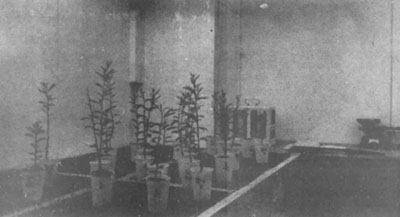 | Details of the growth chamber. P. alba BNF trial. |
| BNF evaluation in Prosopis chilensis with three Rhizobium strains: 163 (R-2), 139 (F) and 156, compared with non-inoculated control (T) and non-inoculated-plus-N treatment. | 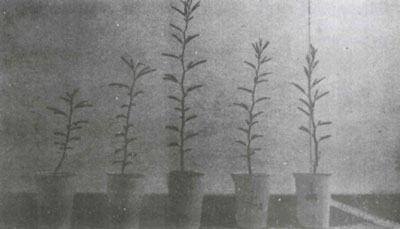 |
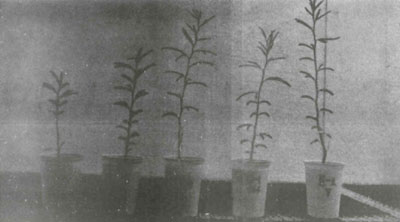 | BNF evaluation in P. alba (II-1) of Region II origin with three Rhizobium strains: 163 (R-2), 139 (F and 156, compared with non-inoculated control (T and non-inoculated-plus-N treatment. |
| Comparison of BNF trials between P. chilensis and P. alba (II-1) with two Rhizobium strains: 163 (R-2) and 139 (F). |  |
REFERENCES
1. CHARREAU C., VIDAL P. 1965. Influence de l'Acacia albida sur le sol, nutrition minerale et rendements des mils Pennisetum au Senegal. L'Agron. Trop. 20, 600–626.
2. DOBEREINER J., CAMPELO A.B. 1977. Importance of legumes and their contribution to tropical agriculture, p. 191–220. In R.W.F. Hardy and H. Gibson (ed). A treatise on dinitrogen fixation, section 4: Agronomy and Ecology, John Wiley and Sons, New York.
3. VINCENT J.M. 1970. A manual for practical study of root-nodule bacteria. p. 164 IBP Handbook. Backwell Scientific Publications, Oxford.
4. SILVESTER W. Personal communication.
5. HARDY R.W., HALSTEN R.D., JACKSON E.K., BURNS R.C. 1968. The acetylene-ethylene assay for N2 fixation: laboratory and field evaluation. Plant Physiol. 43: 1185–1207.
6. FELKER P., CLARK P. 1980. Nitrogen fixation (Acetylene reduction) and cross inoculation in 12 Prosopis (mesquite) species. Plant and soil 57: 117–186.
7. DREYFUS B.L., DOMMERGUES Y.R. 1981. Nodulation of Acacia species by fast- and slow-growing tropical strain of Rhizobium. Applied and Environmental Microbiology. 41: 97–99.
Gabriel Cogollor
Miguel Poblete
Faculty of Agricultural, Veterinary and Forest Sciences
University of Chile
Manuel Cheúl
National Forestry Corporation
Arica, Chile
INTRODUCTION
The Tamarugal Pampa is a plain covering approximately 1,250,000 ha, stretching from the Tiliviche Ravine in the North to the Loa River in the South in Region I. The eastern border is the Andes foothills and the western border the Coastal Range (Figure 1).
Agricultural activity is limited, located at areas where good quality water is available, mainly in small ravines and oases (Habit 1980).
A potentially important resource are the native forests of Prosopis tamarugo Phil., “tamarugo”, the greatest mass of which is located in the vicinity of the town of La Tirana (at the northern edge of the Pintados Salt Flat), with approximately 100 ha.
The tamarugo ecosystem, represented by the Tamarugal Pampa, is considered a pasture aimed at the production of leaves and fruit for animal fodder (Habit 1980).
The Tamarugal Pampa has a 1%–2% east-to-west gradient, with an altitude ranging from 300 to 1,200 m above sea level (Bellinhurst 1983).
This ecosystem has a normal desert climate, characterized by high daytime temperatures, almost total lack of rainfall, occasional mists, low relative humidity and intense sunlight (Habit 1980).
Mean relative humidity is very low, dryness being very marked (51%) (CORFO 1965).
Although air relative humidity during the day varies from 10 to 30%, there are several days in the month when it reaches up to 80% and 100%, with no precipitation during the night. There are normally no great fogs, only 6 to 10 from December to February, coinciding with the rainy season at the Andes Mountains and the High Plateau, known as “Bolivian winter”.
Temperatures range from absolute minimums of -5° C to -12° C, and maximums of 35° and 36° C, with an average of 250 cloudless days a year and 550 cal/cm2 per day. Average monthly evaporation from the soil amounts to 260 m3/ha outside the tamarugo forest and 50 m3/ha within the forest (Toro 1967).
Soils are made up by alluvial deposits from the Andes Mountains and buried beneath a salt crust ranging in thickness from 0.10 to 0.60 m or more.
The salt flats are located preferentially at the southern portion of this Pampa, with an estimated area of 3,750 km2.
The surface of the salt flats presently identifiable (some 1,700 km2) is made up by calcium sulphate and sodium chloride salts, leftovers of the evaporation of a vast lake occupying this section of the Tamarugal Pampa.
The tree species best adapted to this environment is Prosopis tamarugo Phil, with potential for becoming an economic alternative as primary fodder producer (fruits and leaves).
The afforestation program undertaken by the Production Development Corporation (CORFO) in 1965 accomplished the plantation of 20,050 ha of tamarugo, distributed as follows (CORFO Internal Reports):
| Salt Flat | ha |
|---|---|
| Pintados | 12,650 |
| Bellavista | 2,600 |
| Obispo (Zapiga) | 4,800 |
| Total | 20,050 |
Figure 1
GEOGRAPHIC LOCATION OF THE TAMARUGAL PAMPA
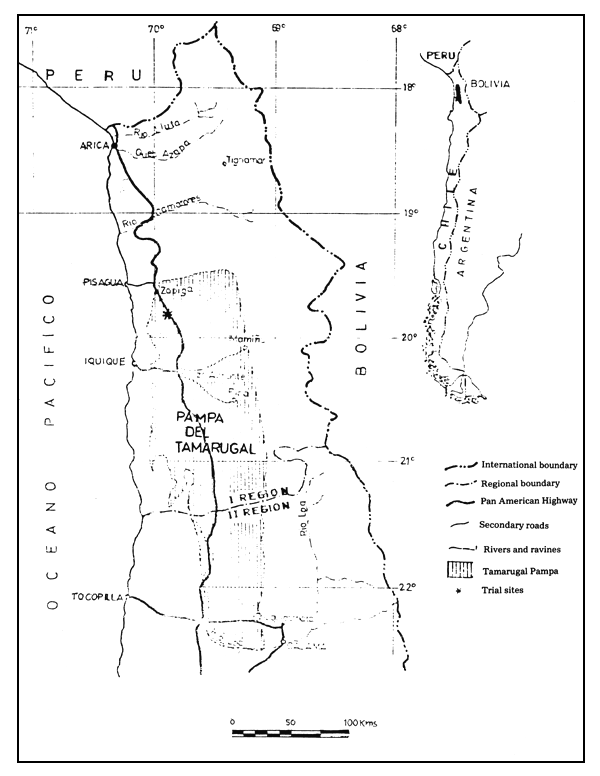
Subsequent research by Toro (1967), Sudzuki et al. (1973) and CORFO (1971), regarding the root system, atmospheric moisture uptake and fodder yields showed the selection of tamarugo as reforestation species to have been very good.
It may already be observed, when travelling through the North Pan American Highway, the change in the scenic beauty and in the environment brought about by the tamarugo plantations, in contrast with the desert; it is noteworthy that the inhabitants of the cities of Iquique and Arica are using this area for recreational activities.
1. ENTOMOLOGICAL DATA
Tamarugo fruit production is affected every year by the relatively frequent occurrence of larvae from lepidoptera which damage inflorescences and young fruit, up to an estimated 75 per cent.
Klein & Campos (1978) studied and described the morphologic distribution, biology and habits of phytophagous arthropods affecting tamarugo, —some endemic to the area— associated with the foliage, twigs, flowers and fruit, indicating, furthermore, the main natural predators found.
Among the species with greater reproductive potential, three lepidoptera stand out: Leptotes trigemmatus Butler, Cryptophlebia carpophagoides Clarke and Ithome sp.
The native pollinators of the different Prosopis spp. in the region, particularly the bee Centrix mixta Friese and the melliferous bee Apis mellifica, introduced from the central part of the country, also represent an important factor in the utilization of tamarugo.
Chemical control trials for the pests affecting tamarugo were subsequently undertaken, showing the possibility of applying treatments with economically profitable products, taking care so as not to affect the pollinating insects.
As to the biologic control, as a response to the constraints inherent to every chemical control measure, research was oriented towards the study of the entomophagous species limiting the populations of the most important pests affecting tamarugo (FAO/BID/1970).
The data indicated above made it possible to design the research for the tamarugo plantations at Zapiga.
The stated goals were to evaluate the damage caused by insects in tamarugo fruit production and study their chemical control.
2. TAMARUGO PLANTATIONS AT ZAPIGA
The tamarugo plantations at Zapiga constitute the northern border of the reforestation activities with this species in the country. They are located 180 km to the South of Arica, 126 km to the East of Iquique, 72 km to the North of the CORFO camp at Refresco, and 31 km to the North of the nearest village, Huara.
The above plantations are arranged into 64 squares 1 km × 1 km (Figure 2), of which the following data regarding afforestation area and date are available (CORFO Internal Reports).
| Planting year | Area | |
|---|---|---|
| 1969 | 200 | |
| 1970 | 1,400 | |
| 1971 | 1,580 | |
| 1972 | 1,400 | |
| 1973 | 600 | |
| Total | 5,180 |
Trees were planted using a square pattern, spaced 13.5 m from one another.
Reforestation activities were started with 200 ha in 1969. These two 1-km squares are located to the south of the CORFO Operations Camp at Zapiga, skirting the Pan American Highway and the Coastal Mountain Range, between the ancient saltpeter mines of Dolores in the North and Negreros in the south (Figure 2). The trial was established in these square sections.
Figure 2
Prosopis tamarugo plantations at the Zapiga Salt Flat
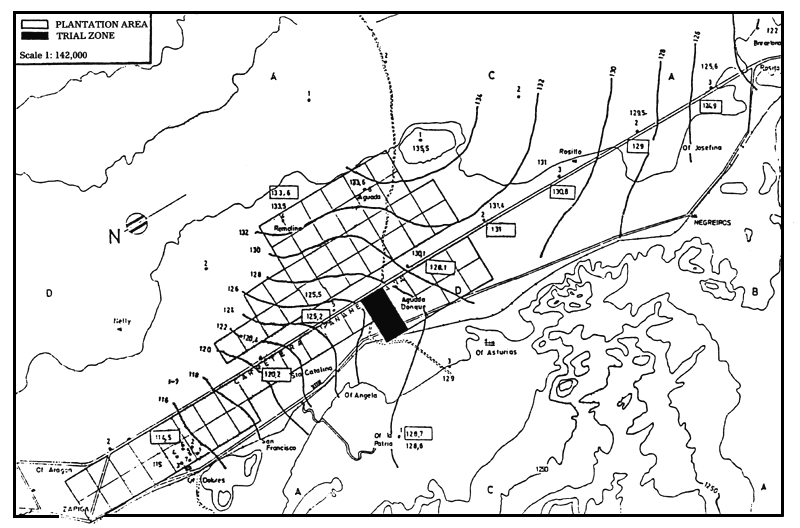
3. DESIGN AND ESTABLISHMENT OF THE TRIALS
3.1 Design of the trials
Given the longer time they had had for adaptation, the survival of the plantation and its location near the CORFO Operations Camp at Zapiga, the two square plots planted in 1969 were selected as study area.
The degree of adaptation of tamarugo over a 13-year span is evidenced by the difference in height and diameter, easily visible when comparing the size of the trees within the plantation rows, among rows and from east to west.
There are site conditions and, possibly, conditions of the genetic constitution of tamarugo, which determine the different growth attained.
Elgueta & Calderón (1971) showed a tight correlation between height growth and age of the tree.
When trying to explain the height development of tamarugo as a function of the depth and salinity of the groundwater table, they could not find any definite trend. Nevertheless, the authors warn, it is not possible, with the analyses performed, to rule out any correlation.
Once the 200 ha planted with tamarugo had been surveyed, and given the east-to-west layout of the squares —besides the data on different depths for the groundwater table (CORFO), which varies from 4 to 20 m at Zapiga— a systematic sampling was established in rows for the evaluation of insect damage on fruit production.
The trial for the chemical control was planned with the following data:
Insecticide:
Thiodan 50 P.M. (Hoechst).
Active ingredient: Endosulfan; Hexachloro-bicyclohepteno — (Oxymethyl) Sulfite in 50%.
Inert and moisturizing matter 50%.
Reason for its use:
The success achieved in comparison with DDT wettable powder 0.14% a.m.; SEVIN wettable powder 0.85% a.m.; MALATHION wettable powder 0.60% a.m. and DIPTEREX wettable powder 0.75% a.m.; THIODAN was the most effective insecticide, with an increase in fruit yields of over 100% (FAO/BID, 1970).
THIODAN is an insectide for the control of sucking and chewing insects, which acts by contact and ingestion. It has selective qualities, as it does not affect parasites and predators. Furthermore, it is well tolerated by bees.
Equipment for application:
200-It motor sprayer mounted on a pick-up truck.
Dosage:
The insecticide was applied in 150 g doses of THIODAN per 100 liters of water.
The average per tree was 32 liters of the solution.
Treatments:
| T0 | = | Fruit production under natural conditions. |
| T1 | = | Fruit production under chemical control. THIODAN was appied from the 15 to the 18 of October. |
| T2 | = | Fruit production under chemical control. |
THIODAN was applied from the 26 to the 31 of October.
The dates for application are related to the amount of flowers open. The literature recommends
to carry out applications with 30–40% of the flowers open. In this trial, the application
was made with 40–50%.
Number of trees in the trial:
T0 = 120 trees
T1 = 45 trees
T2 = 45 trees
Evaluation:
Recording the fruit yield in kg per tree.
4. RESULTS
4.1 Evaluation of insect damage in tamarugo fruit production
| Evaluation | Date | Sample | No. of samples | Damage intensity (%) | Percentage damage (%) |
|---|---|---|---|---|---|
| 1 | 28/IV al 4/X | Flower bunch | 364 | 0–25 | 66.5 |
| 26–50 | 17.0 | ||||
| 51–75 | 8.3 | ||||
| 76–100 | 8.2 | ||||
| 2 | 15–20/X | Flower bunch | 777 | 0–25 | 6.4 |
| 26–50 | 5.4 | ||||
| 51–75 | 12.8 | ||||
| 76–100 | 75.4 | ||||
| 3 | 24–30/XI | Flower bunch | 811 | 76–100 | 92.0 |
| Fruit | 138 | 3 perf. per fruit | 22.2 | ||
| 4 | 7–12/XII | Fruit | 1410 | 5 perf. per fruit | 65.8 |
| 5 | 10–15/I | Fruit | 5936 | 3 perf. per fruit | 59.2 |
| 6 | 10–15/II | Trees | 400 | 336 trees wo/fruit | 84.0 |
| 64 trees w/fruit | 46.0 | ||||
| 7 | 10–15/III | Trees | 365 | all with fruit | |
| Fruit | 2248 | 3 perf. per fruit | 70.0 | ||
| Flower bunch | 323 | 0–25 | 75.8 | ||
| 26–50 | 9.6 | ||||
| 51–75 | 6.5 | ||||
| 76–100 | 8.1 |
4.2 Evaluation of tamarugo fruit production under natural conditions and under chemical control
| Evaluation | Date | Sample | No. of Samples | Damage intensity (%) | Percentage damage (%) | |
|---|---|---|---|---|---|---|
| 8 T0 | 10–15/III | Trees | 120 | 116 trees wo*/fruit | 96.6 | |
| 4 trees w/fruit | ||||||
| Fruit | 42 | 3 perf. per fruit | 52.4 | |||
| 8 T1 | Trees | 45 | 32 trees wo/fruit | 71.1 | ||
| 13 trees w/fruit | ||||||
| Fruit | 318 | 2 perf. per fruit | 59.2 | |||
| 8 T2 | Trees | 45 | 15 trees wo/fruit | 33.3 | ||
| 30 trees w/fruit | ||||||
| Fruit | 1343 | 1 perf. per fruit | 51.1 | |||
| Evaluation | Date | No. of trees surveyed | Trees with fruit | Mean prod. per tree | Production gain | |
| No. | (%) | (kg) | (%) | |||
| 9 T0 | 10–15/IV | 120 | 4 | 3.33 | 0.87 | |
| 9 T1 | 45 | 13 | 28.88 | 2.38 | 273.56 | |
| 9 T2 | 45 | 30 | 66.66 | 4.03 | 463.21 | |
T0 = Fruit production under natural conditions
T1 = Fruit production under chemical control. Thiodan. 15–18/X
T2 = Fruit production under chemical control. Thiodan. 26–31/X
* wo = without
Average height of the surveyed trees was 6.7 m, BHD 10.6 cm and crown diameter 5.6 m.
4.3 Findings of tamarugo fruit production under natural conditions and under chemical control
| Treatment | Sample | No. of samples | Fruit production | Damage | |
|---|---|---|---|---|---|
| No. | (%) | (%) | |||
| T0 | Trees | 45 | 16 | 0.96 | 52.4 |
| T1 | Trees | 45 | 318 | 18.96 | 59.2 |
| T3 | Trees | 45 | 1343 | 80.08 | 51.1 |
Figure 3
Prosopis tamarugo Phil. fruit production under chemical treatment
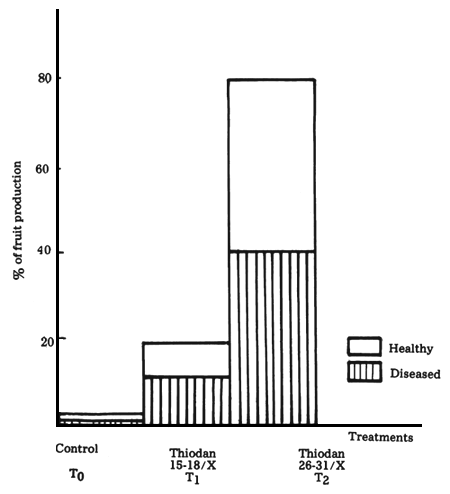
5. CONCLUSIONS
6. RECOMMENDATIONS
REFERENCES
ALAMOS F., PERALTA F. 1980. Evolución de los niveles del agua subterránea en el sector reforestado del Salar de Zapiga. CORFO. Santiago.
BELLINHURST A.G. 1983. La irrigación en Tarapacá. Imprenta y Librería Ercilla, Santiago, Chile.
CADAHIA D. 1970. Informe sobre el Plan Forestal Ganadero Pampa del Tamarugal, Depto. Tarapacá, CORFO. FAO study for the IDB, Chile. (Mimeo). 42 p.
CORPORACION DE FOMENTO DE LA PRODUCCION. 1973. Archivo de documentación sobre el Programa Forestal Ganadero de la Pampa del Tamarugal desde 1969–1973. (Informes internos), CORFO-Iquique, Chile.
CORPORACION DE FOMENTO DE LA PRODUCCION. 1975. Resumen de la investigación entomológica realizada en el Programa Forestal Ganadero de la Pampa del Tamarugal. Archivo de documentación. (Typewritten). 7 p.
ELGUETA H., CALDERON S. 1971. Estudio del tamarugo como productor de alimento del ganado lanar en la Pampa del Tamarugal. Instituto Forestal, Informe No 38, Santiago, Chile. 36 p.
FAO/BID. 1970. Informe sobre el proyecto de plantaciones de tamarugo y explotación ganadera en el Norte Grande, Chile, Washington D.C. (Programa Cooperativo FAO/BID). 264 p.
FORNO H., PINO M. 1978. Evaluación Económica Programa Ganadero Forestal Pampa del Tamarugal. Santiago, CORFO, Gerencia de Desarrollo Iquique. 69 p.
HABIT M. 1980. Contribución al conocimiento del árbol forrajero de desierto Prosopis tamarugo Phil., FAO, Santiago, Chile. 124 p.
INGENIEROS CONSULTORES ASOCIADOS. 1975. Estudio de prefactibilidad de explotación ganadera en base a tamarugo. Pampa del Tamarugal, Iquique. (Typewritten). 105 p.
KLEIN K.C., CAMPOS L. 1977. Biocenosis del tamarugo Prosopis tamarugo Phil., con especial referencia de los artrópodos y fitófagos y sus enemigos naturales. Zeitschrift für angewandte Entomologie. Sanderdruck ans Bol. 85: 86–108.
LAMAGDELAINE L. 1972. Programa Forestal Ganadero Pampa del Tamarugal y Programa Altiplano de Tarapacá. Universidad de Chile CORFO-Iquique, Centro de Documentación. Depto. de Ciencias Sociales Publicación No 2. (Mimeo). 49 p.
SUDZUKI F. 1969. Absorción foliar de humedad atmosférica en tamarugo Prosopis tamarugo Phil. Boletín Técnico No 30, Fac. de Agronomía, Universidad de Chile. 23 p.
SUDZUKI F., BOTTI C., ACEVEDO E. 1973. Relaciones hídricas del tamarugo Prosopis tamarugo Phil. en la localidad de Canchones. Boletín Técnico No 37, Facultad de Agronomía, Universidad de Chile. 23 p.
LEON H. 1974. Estudio comparativo de espolvoreo y pulverizaciones para el control de insectos de tamarugo Prosopis tamarugo Phil. Tesis de Grado, Fac. de Agronomía, Universidad de Chile.
TORO J.M. 1967. Evaporación de distintos tipos de suelo de la Pampa del Tamarugal. (Unpublished) CORFO.